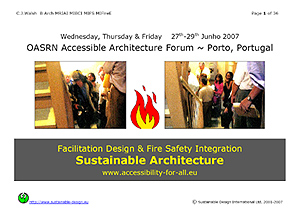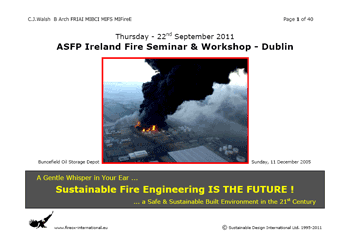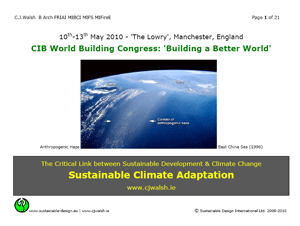|
These are interesting times ; the benefits of modern
technology have bypassed and long overtaken the stirring
thoughts, visions and catchcries of Architects at the
beginning of the 20th. Century. However,
at this time in Europe, we must now ask ourselves some
difficult questions .....
" What should be the Design Agenda for the 'built
environment' in the new millenium ? "
" Do we actually understand the 'real' needs and
desires or 'real' people in an inclusive society ? "
It
is Sustainable Design - the art and
science of the design, supervision of related construction
/ de-construction, and maintenance of sustainability
in the built environment - which is currently
generating a quantum leap in the forward evolution of
a more coherent design philosophy.
Principle
1 of the 1992 Rio Declaration on Enviroment and Development
states......
' Human beings are at the centre of concerns for sustainable
development.
They are entitled to a healthy and productive lifein
harmony and nature. '
Deeply
embedded, therefore, within this philosphy is the concept
of 'person-centredness' , i.e. that core design
value which places real people at the centre or creative
concerns, and gives due consideration to their health,
safety and welfare in thebuilt environment ; a sensory
rich and accessible ( mobility, usability , communications
and information ) environment ; fire safety ; thermal
comfort ; air, light and visual quality ; protection
from ionizing / electromagnetic radiation ; nuisance
noise abatement ; etc. An important 'person-centred'
design aid is the questionnaire survey, which is not
only a very valuable source of information, but formalizes
meaningful consultation between practitioneers and end
users.
|
European
Commission Communication
Brussels 2000-01-18
COM(2000) 6
In
the European Union, a clear legal basis in its Constitution,
continuing political commitment at the level of Council
of Ministers, legally binding compliance with the 1997
Kyoto Protocol, the urgent assignment of the Commission
to implement policies on sustainable development, more
balanced economic progress, social justice and inclusion,
etc., and strong public support for such policies, are
slowly generating sufficient pressure to force a radical
change of pace and direction on what has been, until
now, an inefficient, environmentally destructive, and
very wasteful major industrial sector, i.e. construction.
A proper, rational response for the industry might be
to produce an articulated vision of a future 'built
environment' which deals effectively with this pressure,
and which also clarifies the nature of the task in front
of us, the actions and timescales required, and the
paths to be taken ........
| ' The big picture
on this planet, and the long-term goal over the
next century in Europe, is the creation of a sustainable
'built environment' within a flourishing 'natural
environment', each co-existing with the other in
harmony and dynamic balance, and each in their own
way, capable of providing for responsible and equitable
human, social, cultural and economic development.
And although construction related sustainability
performance indicators will dictate future progress
towards this regional goal, nothing less than a
quantum leap in the evolution of design philosophy
and construction work methods will be required to
even begin to meet this daunting challenge. ' |
Especially
at this time, therefore, there is no greater need than
to encourage creativity and innovation in all aspects
of construction, and to produce a focused, empirical
research agenda. The approach to developing 'real',
cost effective solutions, in the form of practical guidelines,
must be widely multi-disciplinary. An active dialogue
between practitioners, researchers and end-users, based
on direct and meaningful consultation, partnership,
and consensus, must become the standard.
 |
C J Walsh
An Examination of Disability
in the context of
Sustainable Human & Social Development
(Original Paper July 2000 - Published
by McGraw-Hill in USA)
|
The
new World Health Organization's International
Classification of Functioning, Disability and Health
heralds not only a dramatic change in the language and
philosophy of 'disability', which is both positive and
liberating, but the possibility of creating a more tangible,
interactive relationship with mainstream society, because
of its reference to the following 'Contextual Factors'
........
(a)
Environmental :
Those factors which are external, or extrinsic, to
the context of a person's life and living, e.g. the
physical world and its features, other people in different
roles, social attitudes and values, institutional
policies and action programmes, legislation, service
and support systems in society ;
(b)
Personal :
Those factors which are internal, or intrinsic, to
the context of a person's life and living, e.g. age,
gender, level of education, socio-economic status,
and life experiences.
On
the other hand, social turbulence in Europe since the
end of the Cold War, demographic / global warming /
ozone depletion pressures, and the value-driven legislation
of the European Union (E.U.) are combining to alter,
perceptibly, the popular consensus concerning future
human development.
This
Paper examines 'disability' and 'contextual factors'
from the broad perspective of Sustainable Human and
Social Development . It remains, then, for the reader
to decide whether or not the concepts of 'Universal
Design' / 'Design-for-All' are sufficiently elastic
to remain on the European
Disability Agenda for the short term - up to
the year 2010.
May
2001 Update - Presented at the Montreal World Congress
' Inclusion by Design : Planning the Barrier-Free World
'
1st - 5th June, 2001

1998 European Charter on Sustainable Design & Construction
Drafted by CJ Walsh
Having become much more involved in the development of this WebSite
and, specifically, the new way of working in this Electronic Medium,
a different approach to the drafting of Conference/Workshop Presentations was felt
to be very necessary.
For Flexibility and to place the proper emphasis on Content - not on Style,
Conference Presentations after 2002/2003 are in PDF (Portable Document Format).
2004 Rio Declaration on Sustainable Social Development, Disability & Ageing
Drafted by CJ Walsh

Porto, Portugal / 27th-29th June 2007
Sustainable Architecture
Facilitation Design & Fire Safety Integration
(updated after presentation and local interaction)
C J Walsh
Click Here to Download PDF
(PDF File, 2.02Mb)
One of the principal challenges to implementing a Sustainable Approach to
Architecture is achieving a horizontal and seamless integration of many different areas
of Building Performance. In this Presentation, Facilitation Design and
Fire Safety are examined.
Practical Design Solutions for everyday implementation are first elaborated.
These Solutions - important components in a more innovative and robust concept of Accessibility-for-All - are then placed in the context of current European Union law.
Specific mention is also given to Article 11 (Situations of Risk) in the
2006 United Nations Convention on the Rights of Persons with Disabilities.
1948
Universal Declaration of Human Rights

Thursday, 22nd September 2011
ASFP Ireland Fire Seminar & Workshop - RDS, Dublin
A Gentle Whisper in Your Ear ...
Sustainable Fire Engineering IS THE FUTURE !
... for a Safe & Sustainable Built Environment in the 21st Century
CJ Walsh
Click Here to Download PDF
(PDF File, 3.99 Mb)

'The Lowry', Manchester, England / 10th-13th May 2010
Sustainable Climate Adaptation
The Critical Link between Sustainable Development &
Climate Change in the Built Environment
CJ Walsh
Click Here to Download PDF
(PDF File, 721kb)
Asked directly, at a Dublin meeting, about how the relationship between Climate Change and Sustainable Development had been dealt with in the 2007 WMO/UNEP Intergovernmental Panel on Climate Change (IPCC) 4th Assessment Report - where it was mentioned almost as an afterthought - Dr. Rajendra Pachauri, IPCC Chair, replied that he was personally disappointed that something more substantial had not been done to explore this link. He seemed surprised to receive the question.
The 2009 United Nations Framework Convention on Climate Change (UNFCCC) Summit, which was held in Copenhagen from 7th-19th December, was chaotic ... and its outcome was divisive. Since then, it has been particularly noticeable that the IPCC, Dr. Pachauri's position within that organization, and the Science of Climate Change itself ... have all been targeted by an increasing number of vocal sceptics in Developed Countries, particularly the U.S.A. If anything is clear, it is that the Politics of Climate Change must now be carefully dissected and analyzed before an effective global response to Climate Change can be properly mobilized and reliably implemented.
Learning from these events, the urgent priority for those organizations/individuals involved in the design, construction, management or operation of the Built Environment ... is to quickly elaborate a Climate Change Strategy which is 'politically' and 'technically' appropriate for the near and long-terms ... while, at the same time, avoiding any short-term roadblocks to progress.
This Paper explores the symbiotic relationship between the concept of Sustainable Human and Social Development and the reality of Climate Change ... a link which is critical to the development of that elusive consensual global response ... and essential for the effective implementation of a Built Environment Climate Change Strategy.
Fortuitously relevant, in these interesting times ... having commenced in June 2008 ... the on-going development of a CIB Working Commission 108 ('Climate Change and the Built Environment') Project will also be outlined, which will result in the publication of the Report: 'Sustainable Climate Change Adaptation in the Built Environment', during 2010.
|




